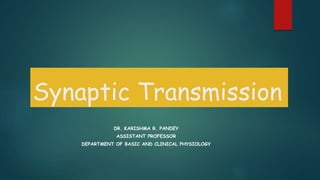
synaptictransmission-150922033443-lva1-app6892 (1).pdf
- 1. Synaptic Transmission DR. KARISHMA R. PANDEY ASSISTANT PROFESSOR DEPARTMENT OF BASIC AND CLINICAL PHYSIOLOGY
- 2. Topics 1) What is synapse and synaptic transmission? 2) Types 3) Structures that form the synapse 4) Process of synaptic transmission 5) Properties
- 3. A number of neurons are involved in the transmission of nerve impulse from its origin to destination. Synapses are the junctions between two neurons.
- 4. Synaptic transmission: communication between neurons
- 5. Two principal kinds of synapses: electrical and chemical
- 9. Synapse Structure The part of the synapse that belongs to the initiating neuron is called the presynaptic membrane. The part of the synapse that belongs to the receiving neuron is called the postsynaptic membrane. The space between the two is called the synaptic cleft. It is approx 20-50 nm wide. Presynaptic terminals contain numerous synaptic vesicles Synaptic vesicles contain Neurotransmitters, chemical substances which ultimately cause postsynaptic changes in the receiving neuron, is contained within the synaptic vesicles. Common neurotransmitters include : Acetylcholine, Dopamine, Norepinephrine (a.k.a., noradrenaline), Serotonin
- 10. Functional Anatomy of chemical synapses • Presynaptic neuron on an average divides into 2000 synaptic endings. Each endings enlarge to form terminal buttons (synaptic knobs). • Synaptic knobs are in close proximity to post synaptic neuron (dendrites, dendritic spines, soma of the post synaptic cell, or axon of the post synaptic neurons). • Most of the synapses are on dendrites.
- 11. Action potential signal arrives at the presynaptic axon terminal Opening of voltage gated Ca channels Ca enters into the presynaptic terminal Ca mediated exocytosis of neurotransmitter Neurotransmitter binds to the receptors at post synaptic membrane Opeining of ion channels Movement of ions through the post synaptic membrane Synaptic potential generated Change in membrane potential in post synaptic membrane Steps of Synaptic Transmission
- 14. Electrical Synapse 1) EPSP short latency 2) Transmission is bidirectional 3) Signal is not magnified 4) Less time consuming for impulse to travel Chemical Synapse 1) Long latency 2) Unidirectional 3) Magnified/modified 4) Time consuming
- 15. Degradation: Enzymes located in the synaptic cleft break down the neurotransmitter into a substance which has no effect on the receptor channel Reuptake: The neurotransmitter can reenter the presynaptic cell through channels in the membrane. Diffusion Fate of the neurotransmitter discharged in the synaptic cleft
- 16. Properties of synaptic transmission 1. Synaptic delay: All the events involved in synaptic transmission need some time usually between 0.5 &1 ms 2. Law of forward conduction: impulse always travels from presynaptic to postsynaptic neuron
- 17. 3a. Spatial summation: If a number of fibers converging on a single neuron are stimulating simultaneously with sub-threshold stimuli, the postsynaptic neuron may fire action potential. 5 5 5 3b. Temporal summation: If a sub-threshold stimulus is repeated several times in quick succession, the postsynaptic neuron may fire. Properties of synaptic transmission
- 18. Properties of synaptic transmission 4a. Facilitation: The effect of stimulating two nerve fibres may turn out to be greater than the sum of stimulating either of them separately. 4b. Occlusion: with stronger stimuli, the effect of stimulating two nerve fibres may turn out to be less than the sum of stimulating either of them separately.
- 19. Properties of synaptic transmission 5. Inhibition: Inhibitory pre-synaptic neuron – release of Inhibitory NT IPSP 6. Fatigue: Repeated stimulation of a synapse leads to gradual diminution and finally disappearance of the postsynaptic response.
- 20. Plasticity of synaptic transmission 1. Habituation: When a stimulus is repeated over and over, the response to the stimulus gradually disappears. 2. Sensitization: When a stimulus accompanied by painful/unpleasant sensation, the response increase is more and more. 3. Posttetanic potentiation: If rapidly repeated stimulation (tetanic stimulation) is followed by a brief pause, the response to subsequent stimulation is frequently enhanced lasts up to 60 seconds. 4. Long-term potentiation: Persistent enhancement of the postsynaptic potential response to presynaptic stimulation after a brief period of rapidly repeated stimulation of the presynaptic neurons. 5. Long-term depression: It is opposite to the LTP. It is characterized by a decrease in synaptic strength.